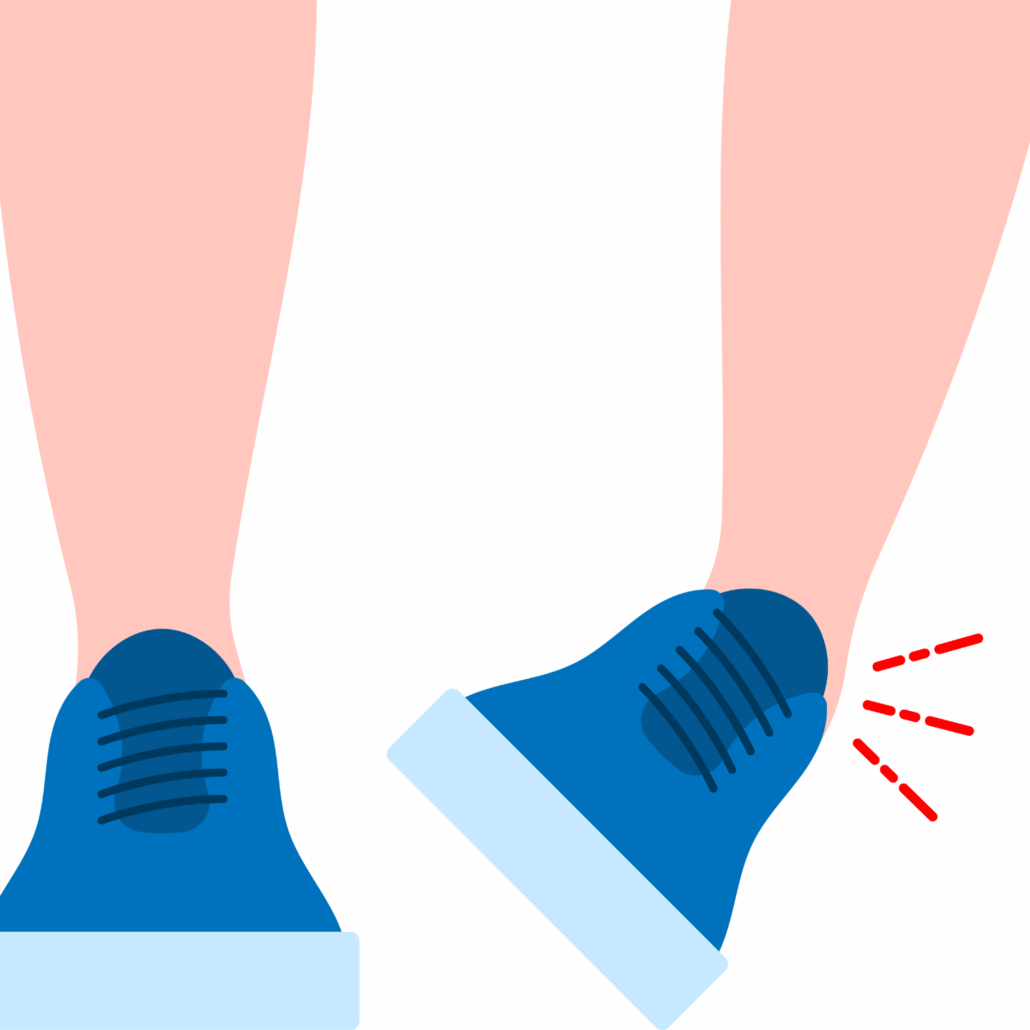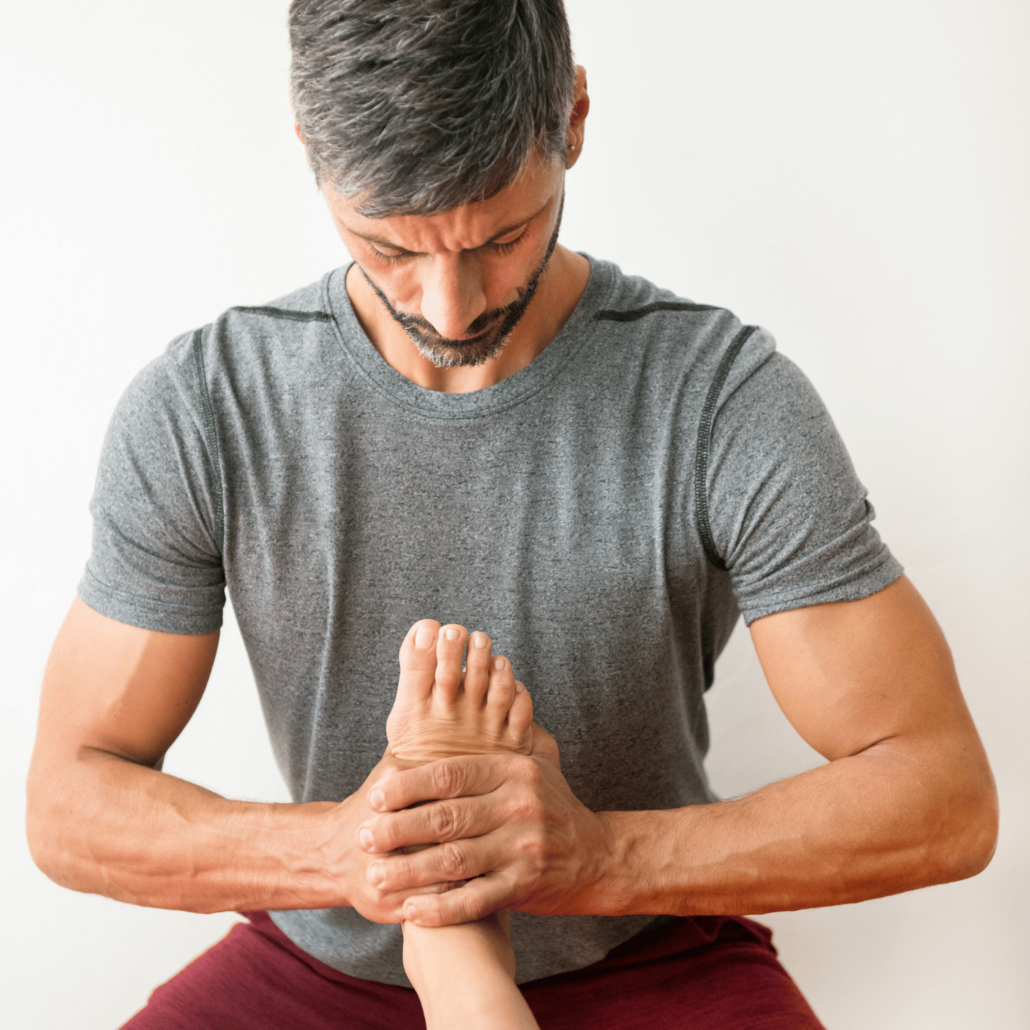Ankle sprains are one of the most common injuries that affect people of all ages. These injuries occur when the ligaments that support the ankle are stretched beyond their limits or tear. Ankle sprains can happen during sports, trips and falls, or by simply stepping off a curb the wrong way.
While ankle sprains are common, they can become a recurring issue if not properly treated and rehabilitated. Osteopathy offers an effective approach for optimising ankle sprain recovery and preventing future injury. This comprehensive guide will provide an overview of ankle sprains, explain the benefits of osteopathic treatment, and share top tips and essential exercises for facilitating recovery.
Understanding Ankle Sprains
The ankle joint relies on several ligaments for stability, with the most commonly injured being:
- Anterior talofibular ligament (ATFL) – Located on the outer ankle, this ligament is injured in about 85% of ankle sprains.
- Calcaneofibular ligament (CFL) – Also located on the outer ankle, injury to this ligament often accompanies an ATFL sprain.
- Posterior talofibular ligament (PTFL) – Found on the inner ankle, this very strong ligament is injured much less frequently.
Ankle sprains are categorised into three grades depending on severity:
Grade 1 (Mild) – The ligament is stretched but no tears. Usually takes 2 weeks to 2 months to heal.
Grade 2 (Moderate) – The ligament is partially torn. Takes around 6 to 12 weeks to heal.
Grade 3 (Severe) – The ligament is completely torn. Can take up to a year for full recovery.
Symptoms of an ankle sprain include pain, swelling, bruising, tenderness, stiffness, instability, and difficulty bearing weight. Immediate treatment consists of resting, icing, compressing and elevating the ankle (RICE method).
Why Osteopathy for Ankle Sprains?
Osteopathy offers an effective approach for treating ankle sprains and facilitating recovery. Benefits of osteopathic treatment include:
- Reduces Pain and Swelling – Osteopaths use massage, stretching and joint mobilisation techniques that enhance circulation and lymphatic drainage to decrease swelling and pain.
- Improves Mobility – Gentle mobilisation techniques restore normal ankle mobility that is often lost after an injury. This prevents compensations and recurrent sprains.
- Supports Healing – Osteopathic techniques promote optimal ligament healing so stability and strength can be regained.
- Identifies Dysfunctions – Osteopaths evaluate the whole kinetic chain to find imbalances that may be contributing to instability and injury risk.
- Speeds Return to Activity – A customised treatment and rehab program gets patients back to their activities faster and stronger.
Top Tips for Ankle Sprain Recoveries
Follow these essential tips for optimal ankle sprain recovery:
- See an osteopath – Osteopathic evaluation and treatment facilitates healing at every stage for the fastest, safest recovery.
- Rest and protect – Avoid activities that aggravate pain and swelling. Use crutches if needed. Don’t rush back into activity.
- Ice and compress – Applying ice packs and compressive wraps reduces swelling and discomfort. Do this several times a day.
- Elevate – Keep the ankle elevated above heart level as much as possible to minimise swelling.
- Take anti-inflammatories – Medication like ibuprofen decreases inflammation and pain. Ask your doctor if appropriate.
- Work on mobility – Gentle stretches and exercises will restore normal ankle mobility and prevent future injury.
- Strengthen the ankle – Targeted strengthening builds stability and proprioception to support function.
- Improve balance – Balance training re-educates the body’s ability to stabilise the ankle during activity.
- Wear a brace – Using an ankle brace or taping provides extra support and stabilisation when active.
- Progress gradually – Stick to your rehab plan and progress activity levels slowly under guidance.
Essential Exercises for Ankle Sprain Recovery
Performing regular rehab exercises ensures you regain ankle strength and mobility for full recovery. Work with your osteopath or physical therapist to determine the optimal program for your needs and recovery stage. Here are 5 essential ankle sprain rehab exercises:
1. Ankle Circles
This simple exercise improves ankle mobility in all directions.
- Sit with legs extended. Lift one leg and draw circles with the foot, rotating at the ankle.
- Complete 10 circles moving the foot clockwise, then 10 circles moving counter-clockwise.
- Repeat 2-3 sets per direction, 1-2 times per day.
2. Alphabet Writing
Writing the letters of the alphabet with your foot targets ankle mobility.
- Sit with legs extended. Use your big toe to “write” each letter of the alphabet in the air.
- Work through the entire alphabet 1-2 times, 2 times per day.
3. Resistance Band Inversion/Eversion
This strengthens the muscles on the inner and outer ankle.
- Sit with legs extended. Loop a resistance band around the forefoot.
- Turn your foot inward against the band to resist, then outward.
- Complete 3 sets of 15 reps, 2 times per day.
4. Single-leg Balance
Standing on one leg challenges stability and balance.
- Stand on the sprained leg, maintaining balance without shifting your body.
- Hold for 30-60 seconds, keeping the stance knee slightly bent.
- Complete 3-5 repetitions, 2-3 times per day.
5. Single-leg Calf Raise
Calf raises build lower leg strength.
- Stand on the sprained leg. Raise up onto your toes, then lower back down.
- Complete 3 sets of 15 reps, holding onto a chair if needed.
- Perform 2-3 times per week.
Recovery Timeline
Understanding the typical ankle sprain recovery timeline can help set expectations:
- Phase 1 (1-2 weeks): Rest, ice, compression, elevation. Use crutches if needed. Begin gentle range of motion exercises.
- Phase 2 (2-6 weeks): Wean off crutches. Progress range of motion and light strengthening. Restore normal gait pattern.
- Phase 3 (6-12 weeks): Advance strengthening and balance exercises. Work on proprioception. Begin light sport-specific training.
- Phase 4 (12+ weeks): Focus on power, agility and speed. Continue strengthening and neuromuscular training. Return to full activity.
Recovery time depends on the severity of the injury. Reinjury can prolong the process. Stick closely to your rehab program and progress gradually under guidance.




